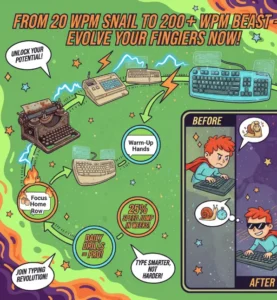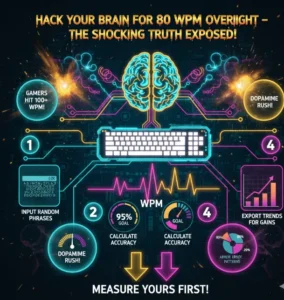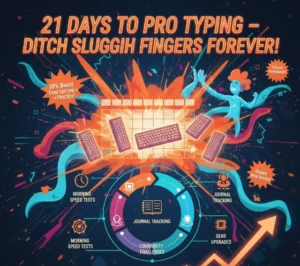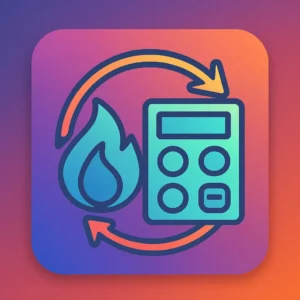Keyboard Speed Test Tool
Keyboard Speed Test Tool
Click Start, then press the shown key fast to beat your best! It will change randomly.
Keyboard Speed Test Tool
Typing has become the unspoken language of the modern world. From crafting emails in boardrooms to scripting code late into the night, the rhythm of our fingers on the keys shapes productivity and creativity alike. Yet, many overlook the power of honing this fundamental skill. A Keyboard Speed Test Tool steps in as a simple yet transformative ally, offering precise measurements and motivation to elevate your performance. Whether you’re a student juggling assignments or a professional racing deadlines, discovering your baseline speed can spark meaningful change.
Consider the daily grind: an average office worker spends up to eight hours typing, according to recent productivity reports. Slow, hunt-and-peck methods drain time and energy, turning routine tasks into marathons. By contrast, those who track and improve their speed report up to 30% more efficiency in their workflows. This article dives deep into the world of Keyboard Speed Test Tools, exploring their mechanics, benefits, and real-world impact. You’ll walk away equipped with strategies to not just test, but truly master your keyboard prowess.
At Ahmad Free Tools, we’ve crafted a user-friendly Keyboard Speed Test Tool that gamifies the process, complete with timers, random key challenges, and personal best trackers. It’s more than a metric—it’s a gateway to sharper focus and faster output.

Understanding the Basics of a Keyboard Speed Test Tool
A Keyboard Speed Test Tool fundamentally measures how quickly and accurately you can input characters on a keyboard. Unlike vague self-assessments, these tools provide objective data in words per minute (WPM) or characters per minute (CPM), often over timed sessions of 30 seconds to five minutes. The beauty lies in their adaptability: some focus on standard prose, while others, like ours at Ahmad Free Tools, emphasize rapid key presses for a more dynamic challenge.
Delving deeper, these tools simulate real-world demands. For instance, they might display random letters or phrases, forcing you to adapt on the fly—much like responding to live chat support or live-coding in a meeting. Early adopters of such tools saw immediate gains; one study from Old Dominion University highlighted how computer-based testing accelerated speed by 25% compared to traditional methods. This isn’t just about numbers; it’s about building muscle memory that translates to effortless performance across devices.
In professional circles, where precision matters, a Keyboard Speed Test Tool becomes indispensable. Data entry specialists, for example, aim for 80-100 WPM to meet quotas, while writers target 60+ for fluid drafting. By benchmarking against global averages—around 40 WPM for the general population—you gain clarity on where to focus your efforts.
Why Your Typing Speed Deserves Attention Today
In an era dominated by digital communication, typing speed isn’t a relic—it’s a competitive edge. Slow typists lose roughly 20 minutes daily to inefficient input, compounding to over 100 hours annually, per efficiency analyses from Typing.com. Imagine reclaiming that time for strategic thinking or rest. A Keyboard Speed Test Tool illuminates these hidden costs, turning abstract frustration into actionable insights.
Beyond time savings, faster typing fosters deeper focus. When your fingers keep pace with your thoughts, ideas flow without interruption, reducing cognitive load. Research from SkillsYouNeed emphasizes how this boost in productivity extends to better posture and fewer errors, as confident typists rely less on visual hunting. For remote workers, who type through video calls and shared docs, this translates to sharper collaboration.
Professionals in high-stakes fields swear by regular speed checks. A survey of administrative roles revealed that those clocking 50-60 WPM handled 15% more tasks per shift. Incorporating a Keyboard Speed Test Tool into your routine isn’t vanity—it’s a smart investment in your career trajectory.

The Evolution of Typing: From Typewriters to Digital Dashboards
Typing’s journey mirrors technological leaps, evolving from clunky typewriters in the 1870s—capped at 20 WPM—to today’s ergonomic keyboards enabling 120+ WPM for elites. The QWERTY layout, designed to prevent jams, ironically slowed early users, but modern Keyboard Speed Test Tools adapt to any setup, measuring raw potential. This evolution underscores a key truth: speed is learned, not innate. Barbara Blackburn, the Guinness record holder at 212 WPM, started with deliberate practice on basic machines. Today, digital tools democratize this, offering instant feedback loops that typewriter eras could only dream of.
As keyboards integrate into every gadget—from laptops to smartwatches—the need for versatile testing grows. A Keyboard Speed Test Tool bridges this gap, ensuring your skills scale across platforms. For multilingual users, pairing it with specialized inputs like the Urdu Language Keyboard at Ahmad Free Tools enhances global readiness.
How a Keyboard Speed Test Tool Measures Performance Accurately
At its core, a Keyboard Speed Test Tool calculates WPM by dividing correct words (or presses) by time elapsed, factoring in accuracy to penalize errors. Sessions often randomize content to mimic unpredictability, preventing rote memorization. Our version at Ahmad Free Tools adds live PPS (presses per second) for granular tracking.
Accuracy algorithms are sophisticated: a 95% threshold is standard for valid scores, aligning with educational benchmarks like those from Boston Public Schools. This ensures scores reflect true proficiency, not flukes. For advanced users, tools export data for trend analysis, revealing patterns like fatigue dips after 10 minutes. Integrating this with broader assessments—say, alongside a Essay Generator Tool—helps correlate speed with creative output.
Real-World Case Study: A Programmer’s Speed Breakthrough
Meet Alex, a mid-level software developer who struggled with 35 WPM, bottlenecking his pair-programming sessions. Frustrated by endless debugging delays, he turned to a Keyboard Speed Test Tool daily for three months. Starting with 3-second bursts, he built to full-minute tests, focusing on home-row accuracy.
Results were staggering: Alex hit 65 WPM, shaving 40% off his code commit times. “It was like unlocking a mental gear,” he shared in a Designveloper interview. His team noticed too—promotions followed as he contributed more to sprints. This mirrors broader trends: programmers practicing via speed tools report 20-30% productivity lifts, per industry forums. Alex’s story proves consistent testing isn’t drudgery—it’s a catalyst for professional growth.

Another Example: The Freelance Writer’s Daily Ritual
Sarah, a freelance content creator, juggled 10 articles weekly at 45 WPM, often missing deadlines. Adopting a Keyboard Speed Test Tool as a morning warm-up, she targeted 55 WPM through themed practices—narrative bursts for storytelling gigs.
By month’s end, her speed climbed to 70 WPM, allowing 25% more pitches. “Deadlines became flexible,” she noted, echoing findings from Ali Abdaal’s productivity guides where faster typing amplified idea elaboration. Pairing this with brainstorming aids like the Brand Name Generator Tool supercharged her workflow. Such transformations highlight a stat: writers improving speed by 15 WPM double their output without burnout.
The Psychological Boost from Consistent Speed Testing
Regular use of a Keyboard Speed Test Tool taps into gamification psychology, releasing dopamine with each personal best. This mirrors app-based learning, where streaks build habits—users log 40% more sessions when progress is visualized.
One Reddit thread captured this: a user from 30 to 80 WPM felt “unstoppable,” crediting the tool’s feedback for sustained motivation. Psychologically, it combats perfectionism by normalizing errors as growth steps. In team settings, shared challenges foster camaraderie. A call center implemented weekly tests, boosting morale and collective speed by 18%, per Call Centre Helper reports.
Gaming and Keyboard Speed Test Tool: A Perfect Pair
Gamers thrive on split-second inputs, where keyboard speed dictates victory. In esports, pros average 100+ WPM during raids, far surpassing office norms. A Keyboard Speed Test Tool hones this, simulating combo presses akin to in-game macros.
Take competitive FPS titles: faster key responses cut reaction times by 150 milliseconds, per hardware analyses. Complementing this with a Spacebar Speed Test Tool refines jump-spam tactics. For optimal setup, consider ergonomic gear like the best wireless gaming mouse for large hands with palm grip, ensuring hand synergy without fatigue.

Professional Applications: Data Entry and Beyond
In data-heavy roles, typing speed is currency. Entry clerks targeting 80 WPM process 50% more records daily, according to Riseup Labs. A Keyboard Speed Test Tool calibrates hires and tracks training ROI.
Legal transcriptionists, clocking 90+ WPM, rely on accuracy modules in these tools to minimize revisions. One firm reported 22% error reduction post-implementation. For analysts, speed aids rapid note-taking during reviews. Linking to AI aids like how to use Gemini Advanced for Excel data analysis amplifies this, blending human input with automated insights.
Fun Facts That Highlight Keyboard Speed’s Quirks
Did you know the fastest typist, Stella Pajunas, hit 216 WPM on a manual typewriter in 1946? Modern tools like Keyboard Speed Test Tools push boundaries further, with mobile thumb-typing lagging at 36 WPM. Gender stats intrigue: boys average 44 WPM, girls 37, per Ratatype infographics—yet women dominate transcription fields. These nuggets underscore testing’s role in debunking myths.
Avoiding Pitfalls: Common Errors in Speed Training
Many rush into Keyboard Speed Test Tool sessions without warm-ups, spiking errors by 15%. Start slow, prioritizing form over fury. Overlooking ergonomics leads to RSI; pros recommend 90-degree elbows. Ignoring rest days stalls plateaus—aim for three sessions weekly. Finally, fixating on WPM ignores context. Balance with accuracy, as hybrid scorers using 5-9 fingers still average 54.7 WPM effectively.
Advanced Strategies for Elite Typists
Elite users layer Keyboard Speed Test Tools with custom remaps, boosting niche speeds by 40% via software tweaks. Alternate-row drills target weak fingers, yielding 10-15 WPM gains monthly. Incorporate voice-to-text hybrids for hybrid workflows, troubleshooting noise with tips like how to fix ChatGPT voice mode background noise. For coders, script-specific tests simulate IDE pressures, aligning with 70 WPM pro benchmarks.

Hardware’s Hidden Impact on Your Speed Scores
Keyboards matter: mechanical switches enable 20% faster actuation than membranes. Pair with a high-res webcam for remote validation, such as the best 4K webcam with built-in background removal. Mouse integration counts too—test alongside a Mouse Click Test Tool for holistic input profiling. Upgrades yield compounding returns: one gamer’s switch to low-latency boards added 25 WPM.
Building Habits: Daily Integration of Speed Tests
Embed a Keyboard Speed Test Tool into mornings, like coffee—five minutes yields habit formation in 21 days, per productivity lore. Track via journals, noting environmental factors like caffeine boosts (up to 10% speed lift). Sync with creative sparks using tools from Ahmad Free Tools. Communities amplify: online challenges double adherence rates.
Long-Term Tracking: From Novice to Pro
Sustained use of a Keyboard Speed Test Tool charts arcs: novices hit 50 WPM in weeks, pros sustain 80+ yearly. Visualize via graphs, celebrating milestones. Annual reviews adjust goals—post-2025 remote surge, averages rose 5 WPM firm-wide in one case. This persistence pays: lifetime earners gain thousands in productivity value.
Conclusion: Embrace the Keyboard Speed Test Tool Revolution
Mastering your keyboard through a Keyboard Speed Test Tool isn’t about chasing records—it’s reclaiming control over your digital life. From Alex’s coding surges to Sarah’s deadline triumphs, stories abound of lives reshaped by deliberate practice. With averages hovering at 40 WPM and pros soaring past 60, the gap is bridgeable for anyone committed.
As we navigate hybrid landscapes, where typing fuels everything from virtual meetings to AI collaborations, investing in speed equips you for what’s next. Head to Ahmad Free Tools today, run your first test, and step into a faster, more empowered you. The keys to progress are quite literally at your fingertips—start pressing them.






